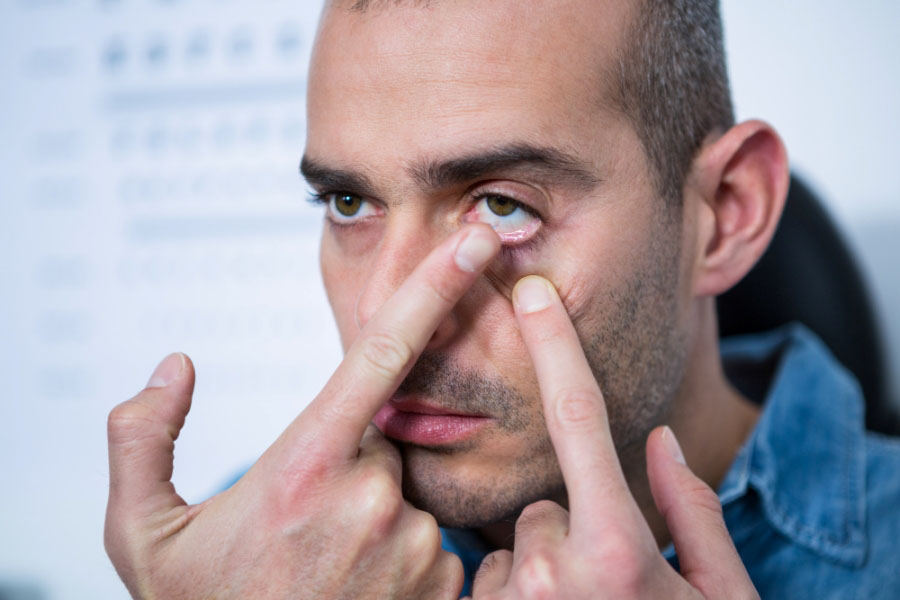Ongoing drug abuse can affect the body in many ways, including the eyes. When you’re trying to identify if someone you care about is abusing Xanax (alprazolam) or wondering how continued Xanax use has affected your well-being, the appearance and function of the eyes is a common place to start.
The term “Xanax eyes” typically comes from the appearance that taking the drug in high doses can cause. For instance, it can often make the eyes look bloodshot, glassy, or dilate the pupils. Plus, in the long term, it can have health effects that lead to vision problems.
We’ve created this guide to help you understand how Xanax affects the eyes. So, whether you’re trying to identify signs of Xanax abuse or want to learn more about Xanax focus problems that impact vision, this article will have the information you need.
Keep reading to learn more about the effects of Xanax and Xanax addiction treatment options that can help.
What People Mean by “Xanax Eyes”
When you hear the term “Xanax eyes,” it’s usually referring to the changes in the appearance of someone’s eyes after taking a high dose of Xanax. Those appearance changes can include:
- Bloodshot or glassy eyes
- Pupils becoming dilated
- Droopy eyelids
- Unfocused gaze
As a benzodiazepine drug, Xanax falls under the category of depressants. That means it slows down your central nervous system (CNS), which is responsible for many important mental and bodily functions. Therefore, when you take Xanax, you’ll notice many of these common benzo side effects on appearance.
Reasons Why Benzos Affect the Physical Appearance of the Eyes
A study from the Journal of International Ophthalmology found that the depressant effects of benzodiazepines like Xanax can slow down tear production. That leads to the eyes becoming dry and getting that bloodshot or glassy appearance.
Another study found that taking benzodiazepines slows smooth pursuit eye movements (the ability to track a moving object). Research found that the main reason for this is that the depressant effects of Xanax can lower eye muscle function. Those changes show physically as droopy eyelids and an unfocused gaze.
Lastly, research published in the Journal of Trends in Neuroscience found that benzodiazepines like Xanax can affect GABA activity in the brain, which is a neurotransmitter that coordinates nerve cell function. When GABA activity is impacted by Xanax, it can cause the pupils to dilate and become more sensitive to light.
How Xanax Affects Focus and Concentration
Since Xanax is a CNS depressant, it can impact visual focus and your overall ability to concentrate. One of the main causes of this is Xanax’s effects on the eye muscles that can slow down your vision, such as your ability to track moving objects. It can slow your reaction time and make trying to focus on something feel really challenging.
These effects can lead to dangerous outcomes. For example, a study from the Journal of Drug and Alcohol Dependence showed that trying to drive while high on Xanax is extremely dangerous since your ability to visually process changes and react is much lower than normal. The effects can be even worse when Xanax is combined with alcohol or other depressant drugs.
Additionally, Xanax can reduce your overall ability to concentrate, cause brain fog, and even lead to memory lapses in high doses. That can lead to negative impacts at work, in school, or in relationships when you continue to use Xanax and experience these effects.
Physical Appearance Changes Linked to Xanax
As someone continues to abuse Xanax, you may see these noticeable changes in appearance occur:
- Tired or “checked out” look: When someone continuously looks tired or checked out, where their eyes are droopy or glazed over, it can be a sign of Xanax use that’s continuing to affect their mind and body.
- Noticeable effects of poor sleep: Research shows that benzos like Xanax can reduce the amount of deep sleep you get at night and overall sleep quality. Poor sleep can result in physical changes such as dark circles under the eyes or a dull complexion.
- Long-term impacts that show physically: Continued Xanax abuse can lead to several long-term health consequences in the eyes that are seen physically, such as cataract development, chronic dry eye syndrome (causing continued redness), or permanent loss of control of eye muscles (known as lazy eye).
Due to the long-term impacts on vision and eye function, it’s important to identify Xanax addiction and seek treatment as soon as possible. We can help with benzo addiction treatment at United Recovery Project if you notice that you or a loved one is struggling.
When Xanax Eyes Signal Something More Serious
While Xanax is a drug that can be medically prescribed to treat anxiety and panic disorders, it can still have serious side effects. If you’re taking Xanax as prescribed but noticing visual side effects, it may be a sign that your body is having a poor response to the medication, and you should consult with your doctor about what you should do.
Additionally, Xanax has a high rate of addiction when misused or abused. That’s why most research recommends only prescribing it for short-term treatment of about 2-4 weeks.
Therefore, if you notice someone taking Xanax for longer than that, having noticeable side effects in their eyes, or having continued Xanax use negatively impact their life in other ways, it may be a sign of addiction that requires treatment.
How to Address Concerns About Xanax Use
There are several steps you can take when you or a loved one is having concerns about Xanax use:
- Talk to your doctor if you’re using Xanax as prescribed but experiencing visual side effects. They may be able to adjust your dosage or switch you to a different medication that works better for you.
- Don’t suddenly stop taking Xanax on your own. Xanax can have severe withdrawal symptoms in some cases, such as seizures or trouble breathing, so it’s important to seek a medical detox to ensure safety.
- Seek professional treatment at a drug and alcohol rehab center to recover from addiction. A full treatment program will provide you with comprehensive therapy, skill building, and relapse prevention planning that leads to better success rates in the long term.
How United Recovery Project Can Help
United Recovery Project is a drug and alcohol treatment center that can help when you or a loved one is struggling with Xanax addiction. When you work with us, we can help diagnose Xanax addiction, find evidence-based treatment options that work best for you, and help you feel confident each step of the way.
Each of our medical detox, inpatient, and outpatient treatment programs is customizable based on your needs to help you achieve the best possible chance of success. We offer many types of therapy, holistic treatment, support groups, and skill building resources to create a plan that works for you.
Recovery from Xanax addiction is possible, and you don’t have to let it keep affecting your eyes or your overall well-being. Contact us today to schedule a confidential consultation or learn more about our treatment options.
References
- Rolando, Maurizio, et al. The Correct Diagnosis and Therapeutic Management of Tear Dysfunction: Recommendations of the P.I.C.A.S.S.O. Board. Vol. 38, no. 2, 1 Apr. 2018, pp. 875–895, doi:10.1007/s10792-017-0524-4. https://pmc.ncbi.nlm.nih.gov/articles/PMC5932107/
- PR Bittencourt, et al. “Benzodiazepines Impair Smooth Pursuit Eye Movements.” British Journal of Clinical Pharmacology, vol. 15, no. 2, 1 Feb. 1983, pp. 259–262, pmc.ncbi.nlm.nih.gov/articles/PMC1427870/?page=2, doi:10.1111/j.1365-2125.1983.tb01495.x. https://pmc.ncbi.nlm.nih.gov/articles/PMC1427870/?page=2
- Tan, Kelly R., et al. “Hooked on Benzodiazepines: GABA Receptor Subtypes and Addiction.” Trends in Neurosciences, vol. 34, no. 4, Apr. 2011, pp. 188–197, doi:10.1016/j.tins.2011.01.004. https://pmc.ncbi.nlm.nih.gov/articles/PMC4020178/
- Aitken, Blair, et al. “Driving Impairment and Altered Ocular Activity under the Effects of Alprazolam and Alcohol: A Randomized, Double-Blind, Placebo-Controlled Study.” Drug and Alcohol Dependence, 8 Aug. 2023, p. 110919, doi:10.1016/j.drugalcdep.2023.110919. https://pubmed.ncbi.nlm.nih.gov/37611483/
- Chen, Lynna, et al. “The Association between Benzodiazepine Use and Sleep Quality in Residential Aged Care Facilities: A Cross-Sectional Study.” BMC Geriatrics, vol. 16, no. 1, 26 Nov. 2016, doi:10.1186/s12877-016-0363-6. https://pmc.ncbi.nlm.nih.gov/articles/PMC5124287/
- Kennedy, Kieran M, and Julien O’Riordan. “Prescribing Benzodiazepines in General Practice.” British Journal of General Practice, vol. 69, no. 680, 28 Feb. 2019, pp. 152–153, doi:10.3399/bjgp19x701753. https://pmc.ncbi.nlm.nih.gov/articles/PMC6400612/



